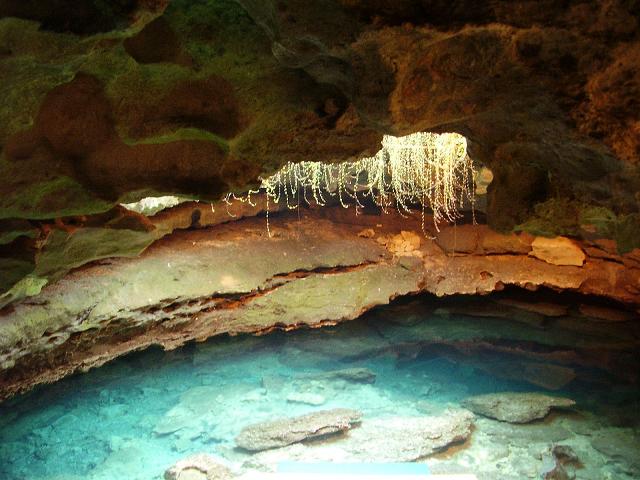Devil's Den Cave on:
[Wikipedia]
[Google]
[Amazon]
 Devil's Den is formed by a
Devil's Den is formed by a
Devil's Den Spring homepage
Archaeological sites in Florida Caves of Florida Landforms of Levy County, Florida Williston, Florida {{LevyCountyFL-geo-stub
karst window
A karst window, also known as a karst fenster, is a geomorphic feature found in karst landscapes where an underground river is visible from the surface within a sinkhole. In this feature, a spring emerges, then the discharge abruptly disappears int ...
, in which the roof over a subterranean river
A subterranean river (also known as an underground river) is a river or watercourse that runs wholly or partly beneath the ground, one where the riverbed does not represent the surface of the Earth. It is distinct from an aquifer, which may flow ...
has collapsed, exposing the water to the open surface, near Williston, Florida
Williston is a city in Levy County, Florida, United States. It is part of the Nature Coast. As of the 2020 census, it had a population of 2,976, up from 2,768 at the 2010 census. It is part of the Gainesville, Florida Metropolitan Statistical ...
. It is privately owned and operated as a SCUBA diving
Scuba diving is a Diving mode, mode of underwater diving whereby divers use Scuba set, breathing equipment that is completely independent of a surface breathing gas supply, and therefore has a limited but variable endurance. The word ''scub ...
training and recreational facility.
The water in the underground river is geothermically warmed at a constant degrees. In cold weather, water vapor rising from the surface of the river forms a visible plume above the entrance to the cave, which suggested a chimney from Hell to early settlers. The opening to the surface was originally a small solution sinkhole, through which visitors had to squeeze to reach the water. The opening was enlarged in the 1990s to ease access. The cave expands below water level (a shape described as an "inverted mushroom"). The diameter of the cave at the surface of the water is about , while underwater the cave is up to across. The maximum depth of the cave reaches . The water level in the cave has fallen along with the water table
The water table is the upper surface of the phreatic zone or zone of saturation. The zone of saturation is where the pores and fractures of the ground are saturated with groundwater, which may be fresh, saline, or brackish, depending on the loc ...
in the area. However, as of 2018, the water level has risen above the main stage/platform. The cave was opened to the public as a dive site in the early 1990s.
Four underwater passages extend from the pool under the opening, from to under the surface of the water. The passage called chamber 3, under water, contained animal and human remains and artifacts. The animal remains, which appeared to be associated with the human remains and artifacts, were from extinct (Pleistocene
The Pleistocene ( ; referred to colloquially as the ''ice age, Ice Age'') is the geological epoch (geology), epoch that lasted from to 11,700 years ago, spanning the Earth's most recent period of repeated glaciations. Before a change was fin ...
) species, including mastodon
A mastodon, from Ancient Greek μαστός (''mastós''), meaning "breast", and ὀδούς (''odoús'') "tooth", is a member of the genus ''Mammut'' (German for 'mammoth'), which was endemic to North America and lived from the late Miocene to ...
s, ground sloth
Ground sloths are a diverse group of extinct sloths in the mammalian superorder Xenarthra. They varied widely in size with the largest, belonging to genera '' Lestodon'', ''Eremotherium'' and ''Megatherium'', being around the size of elephants. ...
s, camel
A camel (from and () from Ancient Semitic: ''gāmāl'') is an even-toed ungulate in the genus ''Camelus'' that bears distinctive fatty deposits known as "humps" on its back. Camels have long been domesticated and, as livestock, they provid ...
s, horse
The horse (''Equus ferus caballus'') is a domesticated, one-toed, hoofed mammal. It belongs to the taxonomic family Equidae and is one of two extant subspecies of ''Equus ferus''. The horse has evolved over the past 45 to 55 mi ...
s, dire wolves, bog lemming
''Synaptomys'' is a genus of North American lemmings. These animals live in wet forested and open areas. They are small, cylindrical rodents with large heads and short ears, legs, and tails. They eat green vegetation such as grasses and sedges. ...
s, Florida spectacled bears, saber-toothed cat
Machairodontinae (from Ancient Greek μάχαιρα '' machaira,'' a type of Ancient Greek sword and ὀδόντος ''odontos'' meaning tooth) is an extinct subfamily of carnivoran mammals of the cat family Felidae, representing the earliest ...
s, and peccaries
Peccaries (also javelinas or skunk pigs) are pig-like ungulates of the family Tayassuidae (New World pigs). They are found throughout Central and South America, Trinidad in the Caribbean, and in the southwestern area of North America. Peccari ...
. One study dated the human remains to about 7500 BC. A more recent study analyzing rare earth element
The rare-earth elements (REE), also called the rare-earth metals or rare earths, and sometimes the lanthanides or lanthanoids (although scandium and yttrium, which do not belong to this series, are usually included as rare earths), are a set o ...
s in the bones found in the cave concluded that the bones of humans and of Pleistocene animals were of about the same age, about 13,000 years old.
References
External links
Devil's Den Spring homepage
Archaeological sites in Florida Caves of Florida Landforms of Levy County, Florida Williston, Florida {{LevyCountyFL-geo-stub